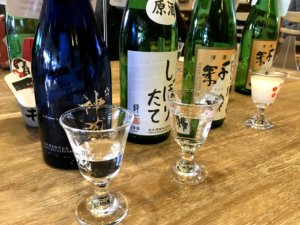Do You Enjoy Sake During “Stay Home Period”?
With fewer opportunities to eat out, there are more opportunities to enjoy sake at home.
It was easy just to order the recommended sake at a bar or izakaya before pandemic. On the top of that, a variety of appetizers and dishes were on the menu, which are perfectly selected by izakaya!
However, when you want to enjoy sake at home, aren’t you buying the same brand of sake bottles every time? and the same for snacks to pair with sake?
Do you wonder what to buy when you go to a liquor store and are you often bewildered by the so many choices?
If you knew the basic ways to enjoy sake, you might be able to enjoy it more.
In this article, I would like to share some tips on how to choose sake so that even beginners can enjoy sake at home.
Get to Know the Characters of Sake
First of all, each sake is categorized into “a specific class name “. The sake with a specific class name is determined by the ingredients, production method, and rice polishing ratio.
Each sake has its own character and uniqueness, but understanding all of them can be quite a daunting process.
In this article, I’ll simply divide them into four main types.

1 Pure Rice (Junmai) Type
- The only ingredients used in pure rice sake are rice and koji.
- Since only rice and koji are used, it is characterized by the rich aroma and flavor of the rice.
Specific class names : Junmai-shu, tokubetsu junmai-shu, some junmai ginjo-shu and junmai daiginjo-shu.
2 Ordinary and Honjozo Type
- The key difference between this type of sake and the pure rice type is the addition of brewing alcohol.
- Brewing alcohol is a distilled liquor made from molasses or corn.
- Ordinary and honjozo sake are characterized by a moderate aroma, light and dry taste, and a cool, refreshing feel.
Specific class names : Honjozo, Tokubonjozo, Ginjo, Daiginjo, etc.
When you hear that sake contains brewing alcohol, you may wonder if it is an additive. Some people may wonder if it is a cheap product. However, the presence of brewed alcohol is not necessarily a bad thing.
Brewing alcohol is used to enhance the aroma of the sake and to make it taste crisp and clean.
3 Ginjo Type
- Ginjo sake is made using a process called “Ginjo-zukuri”.
- The rice is polished more than usual and fermented at low temperature for a long time.
- It is characterized by its fruity aroma and light, refreshing taste.
- Because of the fruity aroma, many sake may have a sweet taste.
Specific class names : Junmai Ginjo-shu, Junmai Daiginjo-shu, Ginjo-shu, Daiginjo-shu, etc.
4 Aged sake, Koshu
- Aged type sake (koshu) is sake that has been aged for a long time, such as long-term aged sake or old sake
- All types of sake can be classified as koshu, as long as they are not unpasteurized.
- It is characterized by a complex and heavy aroma and taste.
Specific class names : Sake other than unpasteurized sake
Let’s Learn the Basics and Enjoy Sake Even More!
Even if sake is categorized as the same type, the aroma and taste will vary depending on the origin of the rice and slight differences in production methods.
It could take a lot of experience and time to find the right one for you! The best way to do this is to keep comparing different types of sake at home.
It is also a good idea to try sake from different breweries, or different types of sake from the same brewery.
Check out Tippsysake, the recommended online sake shop (currently ships only in the US). This could open up your new home drinking experience 🙂
If you’re ever in Fushimi, Kyoto, please join the Kyoto Sake Experience’s Sake Pairing Tour! We promise that you will discover a bottle that you love!

Join Our Sake Tour!
Kyoto is one of the biggest sake producing area in Japan. In Kyoto there’s lots of sake breweries that you can visit.
In our sake experience, you’ll learn the traditional sake making process that has been running for many years.
Not only learning about the secrets of the sake making process, there are some breweries that you can taste the sakes that are made in the brewery. Visit Kyoto’s sake breweries with us and enjoy sake to the fullest.
If you want to learn more about sake, or in order to fully enjoy Japanese culture, don’t forget to join our tour Kyoto Insider Sake Experience. You will discover local sake and learn differences of categories by sampling each of them to find your favourite bottle!


Name: Kotaro
Qualifications: Sommelier of sake
About me:
Founder of Kyoto Insider Sake Experience.
I got a hangover from the first sake I ever drank, which led to a long period where I didn’t drink sake at all. After returning from Australia, I gained some knowledge about sake and discovered its deliciousness and the joy of choosing different types. I’m passionate about sharing this experience with people all around the world.







